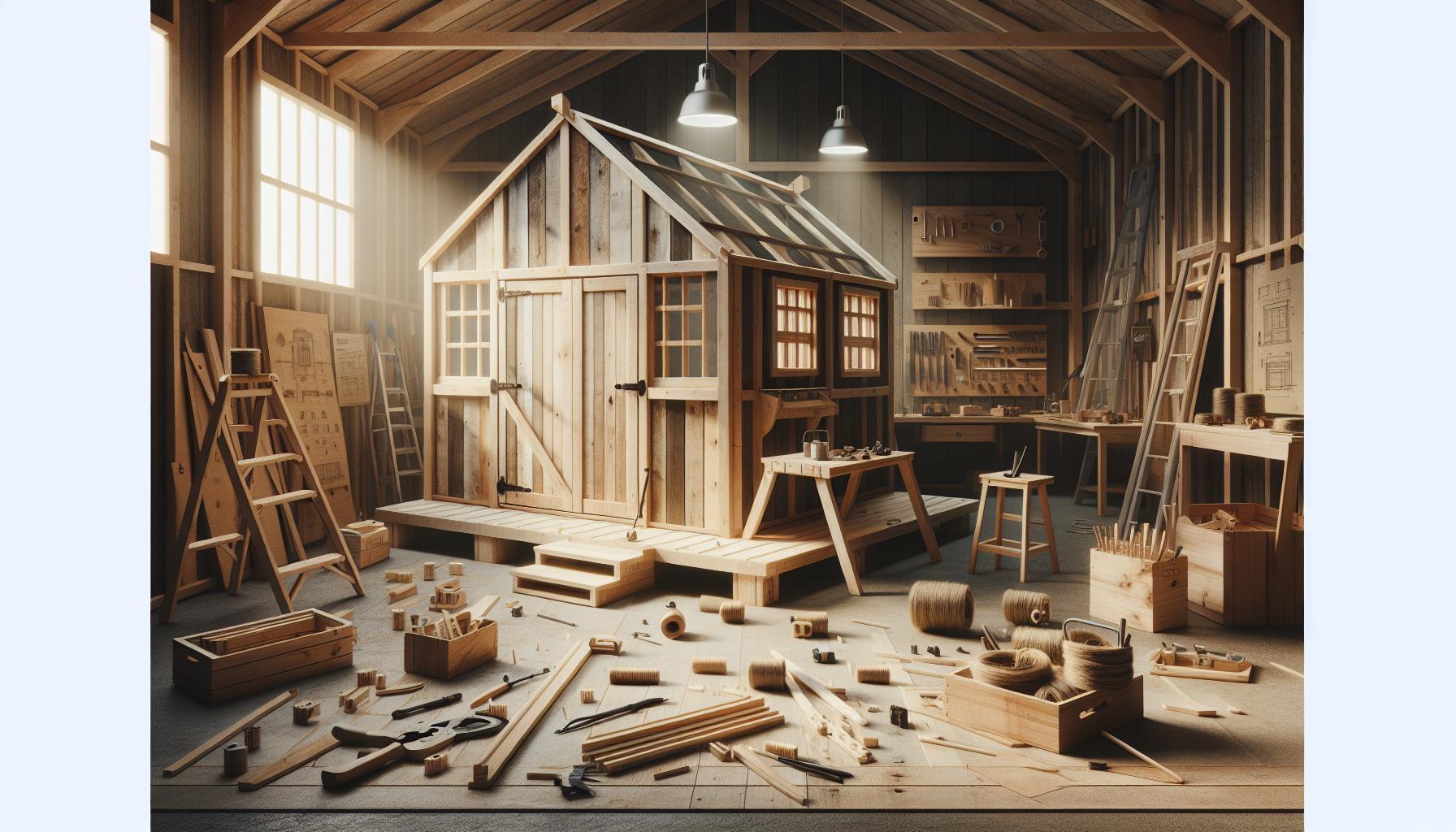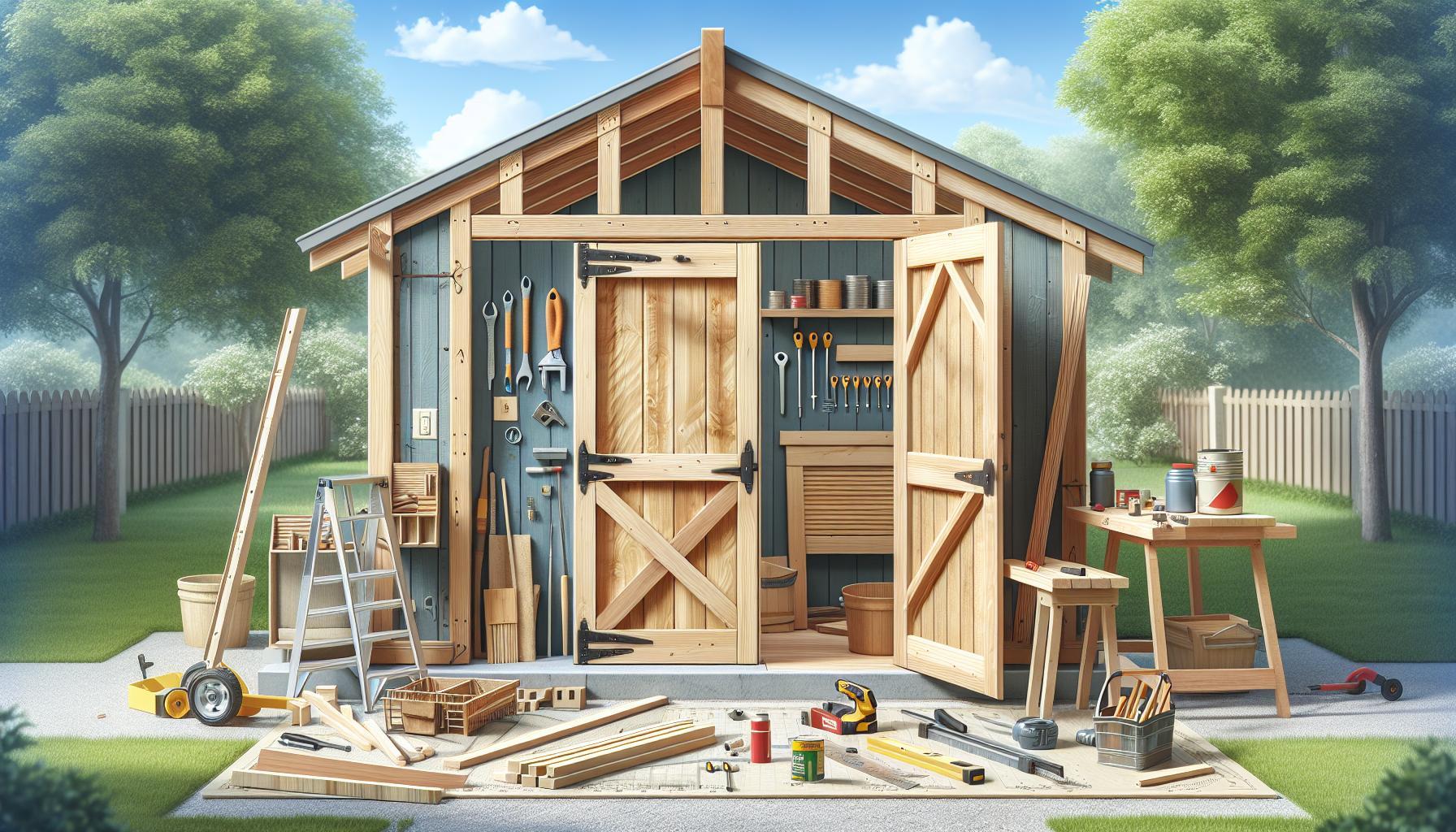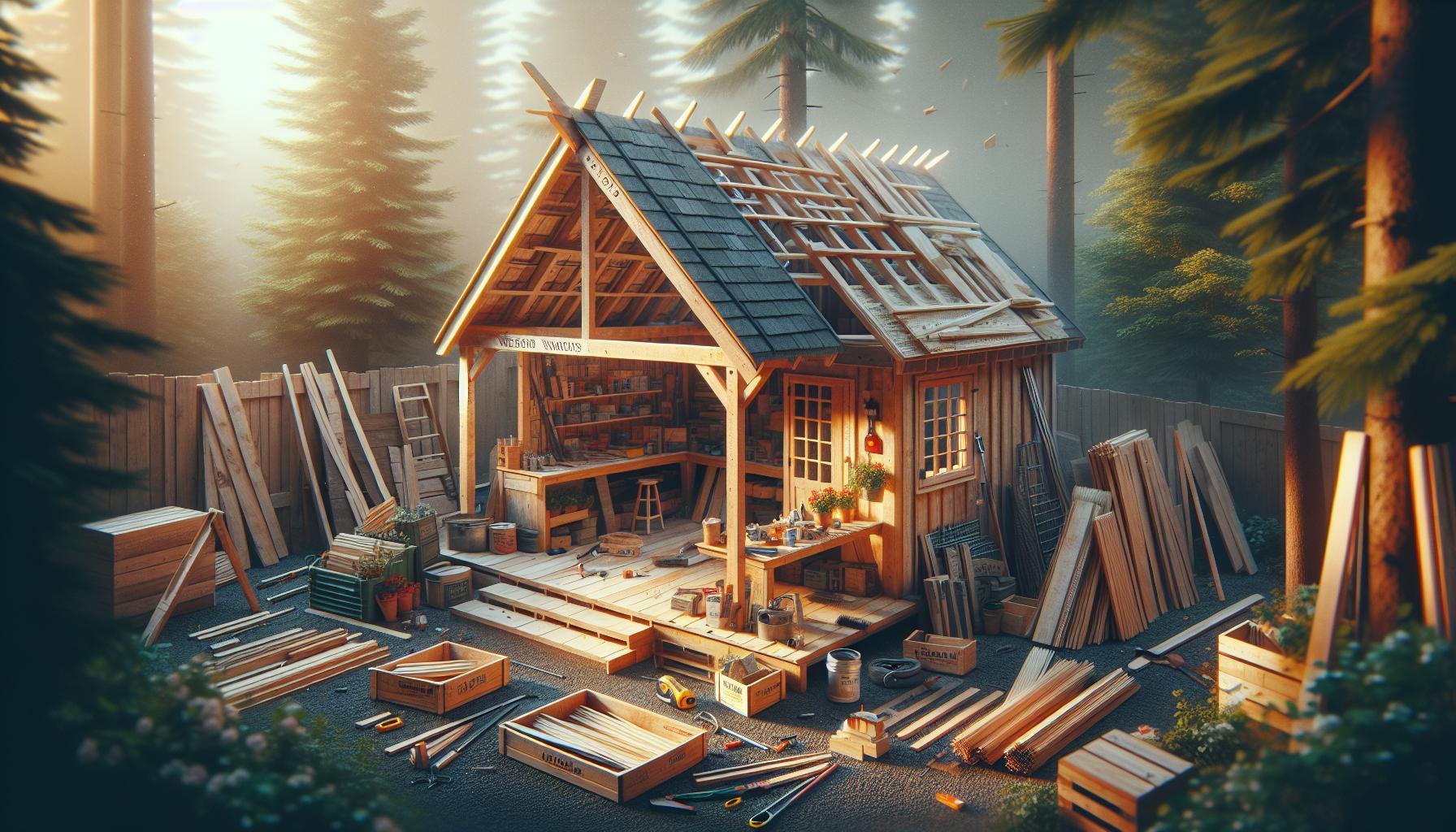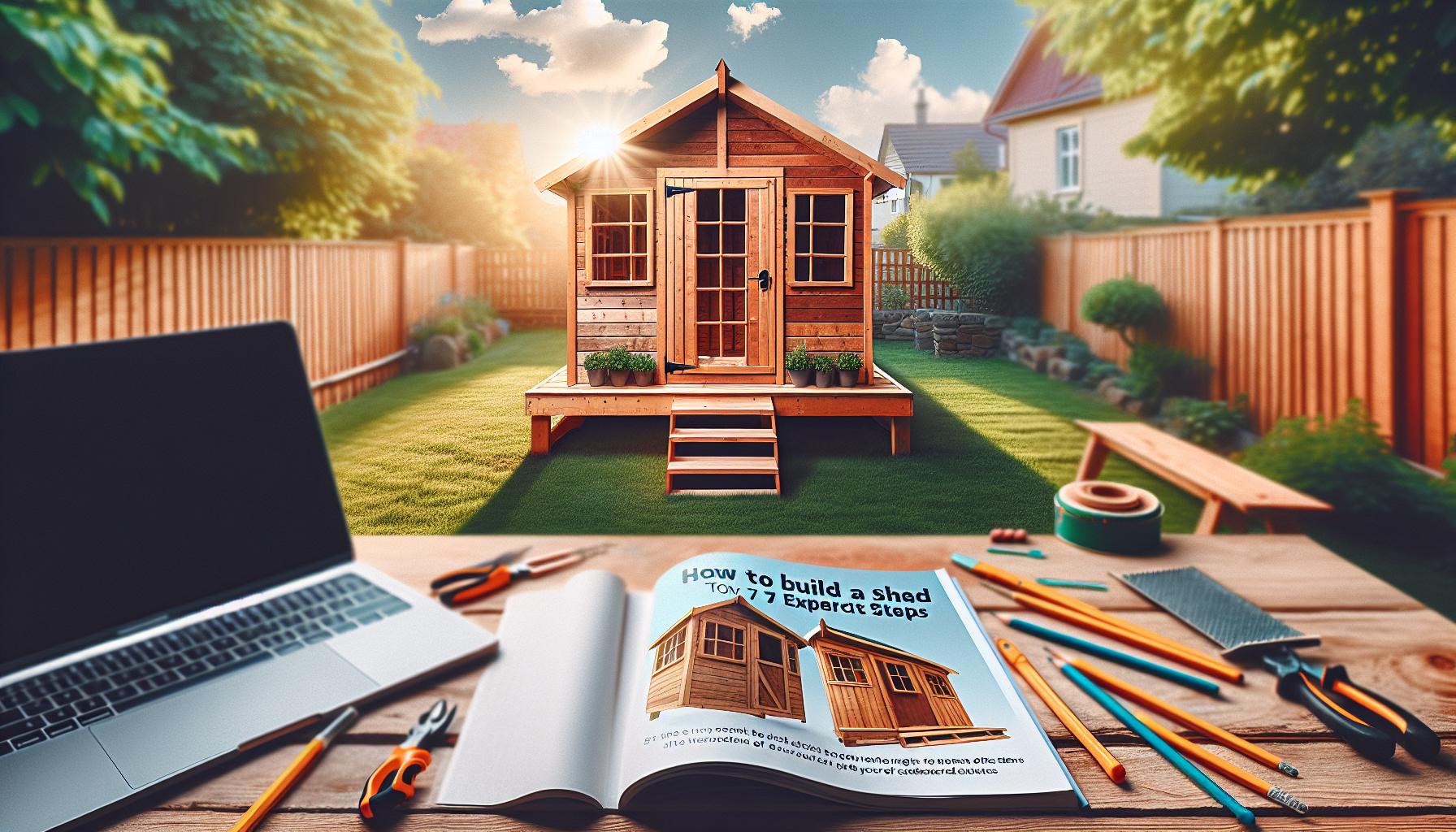Are you struggling to find the perfect space for your tools and projects? Building a workshop shed can transform your cluttered yard into an organized DIY haven, providing ample room for creativity and storage. This guide will walk you through essential steps and tips for constructing the ultimate workshop, tailored to your specific needs and style.
Choosing the Right Location for Your Workshop Shed: Tips for Optimal Placement
When planning your workshop shed, the location can be just as critically important as the design itself. A well-placed workshop enhances functionality, minimizes interruptions, and elevates your DIY experience. Consider that proper placement translates into improved light conditions, access to utilities, and proximity to your home, creating a seamless workflow in your creative oasis.
Assessing Your Space
Before you start digging, take a moment to evaluate your property. Look for areas that allow for easy access while considering natural factors such as sunlight and drainage. Here are some factors to think about:
- sunlight: Identify how sunlight travels across your yard. Positioning your workshop shed to take advantage of natural light can reduce the need for electric lighting during the day.
- proximity to Utilities: If you’re planning to add electricity or water to your shed, placing it near existing lines can save on installation costs.
- Noise and Distraction: Consider placing the shed away from any noise sources, like roads or neighbors, to create a more peaceful working habitat.
- Access: Ensure that your workshop shed is easily accessible for transporting materials in and out,especially if you’ll be using larger tools and equipment.
Understanding Local Regulations and Zoning Laws
Before finalizing your location, familiarize yourself with your local zoning laws and building codes. Depending on your area, there may be specific regulations that dictate how far structures must be from property lines, utility easements, or residential buildings. Securing proper permits not only keeps you compliant but also avoids potential fines or the need for costly adjustments down the line.
Environmental Considerations
Choosing a spot that is environmentally kind will enhance your workshop’s longevity. By considering factors such as wind patterns and potential whether impacts, you can make informed decisions. Such as:
- Wind Direction: Positioning your shed to withstand common wind patterns can definitely help prevent structural damage during storms.
- Flood Zones: Avoid low-lying areas that may be prone to flooding; instead, look for higher ground that offers good drainage away from your workspace.
- Landscape Features: Utilize existing trees and natural barriers to help shield your workshop from harsh weather conditions while also providing a more aesthetically pleasing backdrop.
| Factor | Pros | Cons |
|---|---|---|
| Sunlight Exposure | Natural lighting, energy savings | Overheating in summer |
| Accessibility | Convenient workflow | Potential for distractions |
| Proximity to Utilities | Saves installation costs | Can limit location options |
By keeping these considerations in mind, you’ll be well on your way to creating the ultimate DIY sanctuary for your workshop shed. Taking the time to choose the right location will play a pivotal role in the joy you find in your creative endeavors and the efficiency of your workspace.
Essential planning Steps: Designing Your Dream Workspace
Creating the perfect workspace can be the difference between a dream project and a frustrating endeavor. When it comes to constructing your workshop shed, making thoughtful decisions during the planning process lays the groundwork for a successful DIY experience.A well-designed workshop not only enhances your productivity but also provides a space that inspires creativity and comfort. Here are essential considerations for designing your dream workspace that will take your DIY sanctuary to new heights.
Define Your Purpose
The first step in designing your workshop is to clearly define its primary purpose. Are you focusing on woodworking, electronics, gardening, or crafts? Understanding your main activities will help you tailor the layout and features of your space. For example:
- Woodworking: Consider ample table space,workbenches,and storage for materials like lumber and tools.
- Electronics: Ensure you have adequate electrical outlets, a clean workspace, and a place to safely store delicate components.
- Gardening: A shed with good ventilation and natural light will facilitate plant care and potting work.
Optimize Your Layout
An efficient layout is crucial for making the most of your square footage. When planning your workshop shed, think about the workflow of your tasks. Create zones for different activities, such as cutting, assembly, and storage. A simple flowchart can help visualize the layout:
| Activity Zone | Recommended Features |
|---|---|
| Cutting | Table saw setup,dust collection system |
| Assembly | Large workbench,clamps,hand tools |
| Storage | Shelves,pegboards,containers for tools and materials |
Consider Lighting and Ventilation
Good lighting is essential for any workshop.Natural light is ideal, so if possible, incorporate windows into your design.Combine daylight with bright artificial lighting to reduce eye strain and enhance visibility during detailed projects. Alongside lighting, ventilation is vital for both comfort and safety, especially if you’re working with paints or chemicals. Installing exhaust fans, operable windows, or even a small overhead ceiling fan can substantially improve your workspace’s air quality.
Incorporating these essential planning steps when learning how to build a workshop shed will help ensure that your ultimate DIY sanctuary is not only functional but also a space where you genuinely enjoy spending your time. Take your time to establish your workspace vision, and soon enough, you’ll be crafting in your new haven.
Materials and Tools: What You Need for a Quality Build
One of the most critical components of crafting your ultimate DIY sanctuary is selecting the right materials and tools. The quality of your workshop shed’s build largely depends on the materials you choose and the tools at your disposal, proving that investing time and effort into your preparation pays dividends in the long run. Armed with knowledge about the best materials and essential tools, you can ensure that your workshop remains functional, durable, and aesthetically pleasing for years to come.
Essential Materials
Choosing the right materials is paramount for the longevity and functionality of your workshop shed. Here are key materials to consider:
- Wood: Opt for pressure-treated lumber for the frame, as it resists moisture and rot. For the siding, plywood or OSB (oriented strand board) is a cost-effective choice. Cedar or pine are also great options, providing good insulation properties.
- Roofing Material: Metal roofing is highly recommended for its durability and resistance to leaks; though,asphalt shingles can offer a more customary look while being budget-friendly.
- Insulation: If your workshop shed will be used year-round, consider using fiberglass batts or spray foam insulation to regulate temperature.
- Flooring: A concrete slab is ideal for heavy tools, while treated plywood works well for lighter equipment.
Necessary Tools
Before you dive into your build, ensure you have all the right tools at your disposal. A well-equipped workshop will not only streamline your construction process but also enhance the quality of your workmanship. Here’s a list of essential tools:
| Tool | Purpose |
|---|---|
| Power Drill | For driving screws and drilling holes in various materials. |
| saw | A circular saw for straight cuts and a miter saw for angled cuts. |
| Level | To ensure your structures are perfectly horizontal and vertical. |
| Tape Measure | Essential for accurate measurements to avoid costly errors. |
| Hammer | For driving nails and adjustments on framing. |
| Safety Gear | Includes goggles, gloves, and ear protection to keep you safe while working. |
By carefully selecting high-quality materials and ensuring you have a comprehensive set of tools, you can lay a strong foundation for building your workshop shed. As you embark on your adventure in “How to Build a Workshop Shed: Create Your Ultimate DIY Sanctuary,” remember that a little preparation goes a long way in achieving a professional finish.
Building Codes and Permits: Navigating Legal Requirements
Navigating the regulations surrounding construction can feel overwhelming, especially when building a workshop shed where creative ideas meet practical needs. Understanding building codes and permits is crucial not just for compliance but also for ensuring that your structure is safe, functional, and adds value to your property. Most communities have specific regulations that dictate everything from the dimensions of your building to the materials you can use.To successfully embark on your DIY journey, familiarize yourself with these essential legal requirements.
Understanding Building Codes
Building codes are a collection of rules and standards that govern the construction and alteration of structures, promoting safety, health, and energy efficiency. These regulations vary by location, but typically, they cover areas such as:
- Structural integrity: Ensuring that the shed can withstand environmental factors like wind and snow loads.
- Electrical safety: Standards for wiring and outlets, especially if you plan to use power tools.
- Fire safety: Requirements for fire exits and safe material usage.
Before starting your project, it is wise to consult your local building authority to understand which codes apply specifically to your area. For example, if you’re in Massachusetts, you’ll need to adhere to the rules set out in the current version of the Massachusetts State building Code, which can influence how you design your shed [[3]](https://www.mass.gov/handbook/ninth-edition-of-the-ma-state-building-code-780).
Permits: Why They Matter
In many regions,you will need to obtain a building permit before you begin constructing your shed. This process ofen requires you to submit detailed plans of your project, which will be reviewed by a local code enforcement officer or inspector. They will check your plans against local zoning laws and building codes, ensuring that your shed meets all requirements.
Applying for a permit can provide several benefits:
- Legal compliance: Avoid fines or legal issues that may arise from unauthorized construction.
- Added resale value: A permitted shed can enhance your property’s value and appeal to future buyers.
- Peace of mind: Knowing that your structure is safe and compliant allows you to focus on its functionality and aesthetics.
Tips for a Smooth Permit Process
To streamline your experience when applying for a permit:
| Tip | Description |
|---|---|
| Research | Check the local building department’s website for necessary documentation and fees. |
| Prepare detailed plans | Include dimensions, materials, and intended use to avoid delays. |
| Consult an expert | If you’re uncertain about the codes, consider hiring an architect or contractor. |
| Follow up | Stay in contact with the building department for any updates or requests for additional facts. |
By carefully navigating the complexities of building codes and permits, you can ensure that your workshop shed not only meets your expectations but also adheres to all necessary legal requirements. This planning stage is just as important as the construction itself, paving the way for your ultimate DIY sanctuary.
Interior Layout: Creating Functional Zones for Your Projects
Creating an effective interior layout is crucial when it comes to building a workshop shed that not only meets your DIY needs but also enhances your productivity.By thoughtfully organizing your space into functional zones, you transform your shed into a sanctuary of creativity and efficiency. the layout can make or break your experience, as a well-structured area allows for seamless workflow and minimizes distractions, providing you with the ultimate environment for your projects.
Identify Your Essential Zones
To optimize your workshop, start by identifying the primary functions you will need. Consider dividing your shed into the following essential zones:
- Tool Storage: Allocate a dedicated area for your tools based on frequency of use. Consider wall-mounted pegboards for easy visibility and access.
- Workstation: Your workbench should be located centrally to facilitate movement. Ensure it has sufficient space for larger projects and is paired with adequate lighting.
- Supplies and Materials Zone: Organize your materials in labeled bins or shelves, making it easy to grab what you need without rummaging around.
- Finishing Zone: This is where you’ll handle paint, varnish, or other finishing touches. Installing an exhaust fan and ensuring good ventilation is essential in this area.
Strategically Plan Your Flow
A practical approach is to create an efficient workflow by placing all zones in a logical sequence. Such as, you might start with raw materials coming in, followed by processing on the workbench, then finishing, and finally storage. This arrangement allows you to move through tasks without backtracking.
| Zone | Key Features | Considerations |
|---|---|---|
| Tool Storage | Pegboards,Tool Racks | Access to frequently used tools |
| Workstation | Sturdy Workbench,Good Lighting | Space for tools and materials |
| Supplies Zone | Bins,Labels | Visibility and accessibility |
| Finishing Zone | Ventilation,Protective Gear | Safety from fumes |
When designing your workshop shed,keep in mind the importance of ergonomics. Your layout should consider the height of countertops, the reach of shelves, and the positioning of tools to minimize strain during prolonged use. integrate adjustable elements such as a fold-down workbench or height-adjustable shelving to allow for adaptability as your needs evolve.
These strategic choices will elevate your shed from a mere storage space to a dynamic workshop where you can dive into projects easily and efficiently. With each functional zone tailored to your workflow, you’ll find that your DIY sanctuary inspires both creativity and productivity, making every project a satisfying accomplishment.
Insulation and Ventilation: Ensuring Comfort Year-Round
Creating a comfortable and functional workshop shed demands careful attention to both insulation and ventilation. These two critical elements work together to help maintain a stable internal climate, allowing you to focus on your projects year-round, regardless of the weather outside. A well-insulated shed can keep you warm in the winter and cool in the summer, making your DIY sanctuary inviting and productive.
Why Insulation Matters
insulation is the foundation of comfort in your workshop shed. It acts as a barrier to heat flow, preventing unwanted heat from escaping during cold months and blocking excess heat from penetrating in the summer. Here are a few insulation options you might consider:
- Fiberglass Insulation: Commonly used for its efficiency and cost-effectiveness; installation can be DIY-friendly.
- Foam Board Insulation: Provides excellent thermal resistance; ideal for both walls and ceilings.
- Spray Foam Insulation: Offers high R-value and can fill gaps, but may require professional installation due to its complex process.
Taking the time to insulate your shed not only enhances comfort but also improves energy efficiency, perhaps saving you money on heating and cooling costs over time.
Ventilation: the Key to Air Quality
Ventilation is equally vital for creating a conducive work environment. A well-ventilated workshop helps to regulate humidity levels, preventing molding and allowing for the safe use of materials and tools that might release harmful fumes. Effective ventilation strategies include:
- Passive Ventilation: Configure vents near the roof and at lower levels to allow warm air to escape and cool air to enter.
- Active Ventilation: Install exhaust fans or air exchangers to enhance airflow, especially useful in larger sheds.
- Windows and Skylights: Incorporate operable windows and skylights to harness natural light and promote cross-ventilation.
Combining these ventilation methods ensures that your workspace remains fresh and free of stagnation, encouraging productive and healthy DIY sessions.
Balancing Insulation and Ventilation
It’s important to strike a balance between insulation and ventilation to achieve the ultimate comfort in your workshop shed. Here are some considerations to keep in mind:
| aspect | Insulation | Ventilation |
|---|---|---|
| Objective | Maintain temperature | Regulate air quality |
| Best Practices | Seal all gaps; use high R-value materials | Install minimal openings; use fans strategically |
| DIY Tips | Consider DIY insulation panels | Simple passive systems can be effective |
By thoughtfully integrating insulation and ventilation into your workshop shed design, you’ll not only create an ultimate DIY sanctuary but also enjoy a space that fosters creativity and productivity throughout the year. Whether you’re crafting, woodworking, or engaging in any other projects, the right combination will ensure your comfort and safety, making your shed a beloved retreat from the world.
Personalizing Your Shed: Adding Character and Practicality
When envisioning your workshop shed, consider this: it’s more than just a space for tools and materials; it’s an extension of your personality and an expression of your passion for DIY projects. By customizing your shed, you can create an inviting atmosphere that not only fuels creativity but also serves practical purposes to enhance your working environment. Let’s explore actionable ways to imbue your workshop shed with character and functionality.
Incorporating Practical Features
To make your workshop shed both functional and aesthetically pleasing, it’s critically important to integrate practical features that enhance your workspace. Consider the following options:
- Shelving and storage Solutions: Install adjustable shelving units to keep tools and materials organized. Use clear bins and labeling systems to easily locate items.
- Workbenches: A sturdy workbench is the heart of any workshop. Customize the size and height to suit your projects and personal comfort. Add drawers or storage underneath for added convenience.
- Task Lighting: Good lighting is essential. Incorporate LED strips or adjustable lamps that can be directed where needed, ensuring you can work on detailed tasks without straining your eyes.
- Power Sources: Plan for sufficient electrical outlets, ensuring you have enough power for tools and equipment without overloading circuits. A dedicated circuit for heavier machinery is a smart addition.
Personal Touches That Reflect Your Style
the aesthetic of your workshop can transform it from a simple shed into a personal haven. Here are some ideas to infuse character into your space:
- Color Schemes: Choose colors that inspire you. Bright colors can energize a space, while softer tones may create a calming atmosphere.
- Artwork and Décor: Hang tools or projects you’ve completed as art,or consider adding wall decals that resonate with your personality,creating a vibrant backdrop.
- Custom Signage: Personalize your workshop with a custom nameplate or sign. Whether it’s a playful name or simply your initials,this small touch speaks volumes about your unique style.
- Plant Life: Incorporate small plants or herbs. Not only do they purify the air, but they also add life to the workspace, making it feel more inviting.
Adding Comfort for Extended Hours
Spending long hours in your workshop shed can take a toll, which is why comfort is a crucial factor in personalization. Consider these enhancements to ensure you can work for hours without discomfort:
- seating: A comfortable chair or stool is vital, especially for projects requiring prolonged focus. Think ergonomic designs that support good posture.
- Climate Control: Depending on your location, you may want to add insulation, fans, or a small heater to keep your space comfortable year-round.
- noise Control: If your workshop is near a residential area, soundproofing can be beneficial. Add thick curtains or acoustic panels to minimize noise while you work on those loud projects.
Incorporating these elements will make your workshop shed not just a place to work but a sanctuary where creativity flourishes. By marrying practicality with personal touches, you will create a space that truly reflects your passion for DIY projects and serves as a haven for your craftsmanship.
Maintaining Your workshop Shed: Tips for Longevity and Care
Regular maintenance of your workshop shed is essential not only for preserving its structural integrity but also for ensuring that it remains a productive and enjoyable space. just as you took care and precision in constructing your sanctuary, ongoing care will enhance its longevity and functionality. A well-maintained workshop can significantly improve your DIY experience, turning it into the ultimate creative haven as you dive into future projects.
Essential Maintenance Tips
Routine checks and simple tweaks can make a world of difference. Here’s a list of key maintenance activities that will keep your workshop shed in prime condition:
- Inspect the roof: Look for signs of wear and tear, such as missing shingles or leaks. Addressing these issues early can prevent costly renovations later.
- Clean gutters: Ensure that debris does not block water flow; this can lead to overflow and damage to your shed’s structure.
- Seal doors and windows: Regularly check seals for gaps or wear to keep out moisture and pests.
- Paint and treat wood: Apply weatherproof finishes to protect against the elements, which is especially important if your workshop shed is made of wood.
Seasonal Care Checklist
Seasonal changes can bring unique challenges to your workshop shed. To tackle these effectively, consider employing a seasonal care checklist to ensure you’re ahead of any issues. Below is a simple table with seasonal tasks you may want to perform:
| Season | Maintenance Tasks |
|---|---|
| Spring | Inspect roof, clean gutters, check for moisture-related issues. |
| Summer | Repaint or restain wooden surfaces, inspect for pests, ensure good ventilation. |
| Fall | Clear leaves from gutters and the shed periphery, check insulation levels. |
| Winter | Inspect heating sources, clear snow from roof and entrance. |
Pest Prevention Strategies
To make your workshop shed a true sanctuary, it is crucial to keep it pest-free. Here are some effective strategies:
- Seal gaps: Use caulk or weather stripping around doors and windows to prevent small animals from entering.
- Store materials properly: Use airtight containers for stored supplies to deter pests.
- Regularly clean the workspace: A clean area calls for less pest attraction; take time to declutter.
By implementing these maintenance practices, you will not only maintain the integrity of your workshop shed but will also ensure it remains a welcoming and inspiring place to foster your creativity. Keeping your ultimate DIY sanctuary in tip-top shape will enhance both the value of your investment and the enjoyment of your hobby.
Q&A
How to Build a Workshop Shed: Create Your Ultimate DIY Sanctuary?
To build a workshop shed, start by planning your design, acquiring necessary permits, and choosing materials. Focus on key elements like foundations, insulation, and ventilation to ensure a functional and comfortable space.
Consider the size and layout based on your specific needs, whether for woodworking, crafting, or storage. It’s essential to comply with local building codes. You can learn more about these requirements in our detailed article on building permits.
What is the best location for a workshop shed?
The best location for a workshop shed is a spot that’s level, well-drained, and easily accessible. Ensure it’s close enough to your home for convenience while being far enough to minimize noise disruption.
Consider sunlight exposure and natural shade elements, which can definitely help in temperature regulation.Additionally, think about your workshop’s proximity to electrical outlets or water sources, enhancing functionality in your ultimate DIY sanctuary.
Why does insulation matter when building a workshop shed?
Insulation is crucial for maintaining a comfortable working environment in your shed. It helps regulate temperature, reducing heating and cooling costs, and prevents moisture buildup.
Using appropriate insulation materials, like foam boards or fiberglass, can significantly enhance your workshop’s energy efficiency. Effective insulation makes your workspace more enjoyable year-round, especially when you’re engaged in long projects during cold winters or hot summers.
Can I build a workshop shed without prior experience?
Yes, you can build a workshop shed without prior experience! Start with a solid plan, gather resources, and learn as you go. Many online tutorials and community forums offer invaluable advice for beginners.
Great tools and resources like videos and DIY guides will help you navigate the building process.Don’t hesitate to ask for help or advice from more experienced builders; their insights can save you time and frustration.
How much does it cost to build a workshop shed?
The cost of building a workshop shed varies widely based on sizing, materials, and features, typically ranging from $1,500 to $5,000. Consider budgeting for permits, tools, and any specialized equipment you may need.
By selecting cost-effective materials and planning carefully, you can optimize your budget and still create an attractive and functional space. Think of ways to use reclaimed materials, which can reduce costs while also adding character to your shed.
What are the essential features of a well-planned workshop shed?
A well-planned workshop shed should include adequate storage, workspace, lighting, and electricity. Prioritizing these features will maximize your productivity and make your shed a joy to work in.
Install shelves, pegboards, and workbenches for organization. Good lighting and electrical access enable you to work comfortably during any hour. Remember to include ventilation options, like windows or vents, to maintain airflow and minimize humidity.
How do I ensure my workshop shed is compliant with local codes?
To ensure compliance with local codes when building a workshop shed,start by checking your local regulations regarding zoning,setbacks,and building permits. This ensures that your structure is legally permissible and avoids headaches down the road.
Engaging with your local building department is key—they can provide specific guidelines and requirements.Be sure to document your construction process, which may be necessary for inspections or future assessments.
Final Thoughts
As you embark on the exciting journey of building your ultimate DIY workshop shed, remember that this space is more than just a structure; it’s a sanctuary for creativity, craftsmanship, and personal growth. We’ve covered essential steps from planning and designing to choosing materials and understanding zoning regulations.Whether you’re a novice or an experienced builder, the knowledge gained here can empower you to overcome potential challenges with confidence.
Building your workshop shed allows you to tailor your environment to your needs, fostering productivity and joy in your projects. Don’t forget, each challenge you encounter is an possibility for learning and improvement, reinforcing your skills for future ventures. Take the leap, invest in your dreams, and with persistence and passion, your workshop shed will transform into a thriving hub of activity.
We encourage you to delve deeper by exploring additional resources or connecting with fellow DIY enthusiasts who share your vision. Embrace the journey ahead and let your workshop shed be a canvas for your talents—a place where ideas take shape and craftsmanship flourishes. Happy building!








